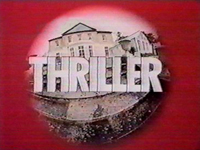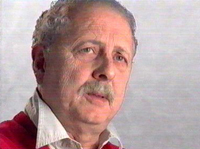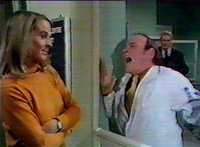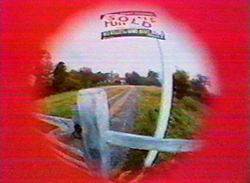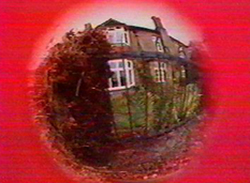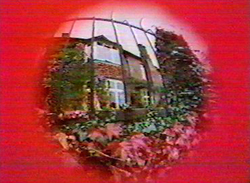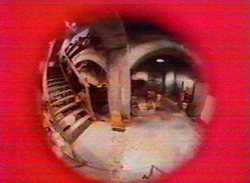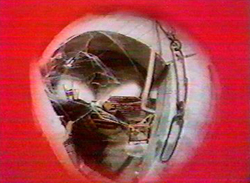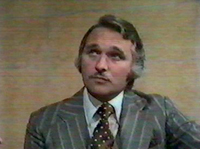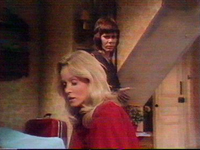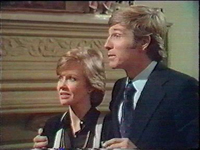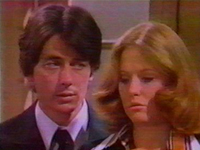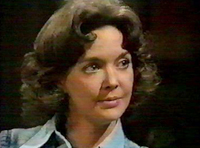THRILLER
Stories of mystery, horror and suspense - this is arguably one of Britain's best series!
Although it's not very well known today. In its heyday it was shown even in the US, and it sold reasonably well within Europe. Germany bought eleven episodes which were dubbed into German by one of the Public TV networks, ZDF. As in the US the English contributions were mixed with American television films. Thriller remained the umbrella title. Belgium bought at least 23 and showed them with subtitles. The Netherlands, also a subtitles country, showed at least 7. In addition to that the series was broadcast in France (dubbed), Italy (dubbed), Denmark (subtitled, all 43 episodes in their original formats by the sound of it). The list may be longer but information is restricted to these countries at this moment. See Thriller broadcast dates for more details and UK Bravo transmissions.
Despite a low budget approach (Videotape Recording) + filmed inserts) and a minimum of special effects Thriller episodes manage to create an immense tension, often in the gothic horror ("tales of the macabre, fantastic and supernatural, usually set amid haunted castles, graveyards, ruins, and wild picturesque landscapes"; Oxford Companion to English Literature) tradition. A typical Thriller plot sounds like this: Hired assassins take control over a clinical training centre for the blind which they intend to use as operational base to carry out their assignment. It is unlikely that the blind students will have any chance against the overwhelming force of their opponents ...
Another: A couple moves into a new house in the country. At night the sound of footsteps can be heard, then a body is found in the cellar, and the husband starts to behave strangely ...
On the origins of Thriller Ian Kerr, the leading authority on the series, has this to say:
"In late 1972, after writing several scripts for ITC productions, [Avengers writer and producer] Brian Clemens approached Michael Grade with an idea for a production of his own. Grade then approached his uncle, and head of ITC, Sir Lew Grade, with the idea. Brian had taken the idea of stories that develop menace and terror in the mind without resorting to graphic scenes of violence or horror on the screen as the basis for a new anthology series. Lew Grade, a man renown for thinking on his feet and who was always eager to put money up for what he considered good ideas, commissioned ten scripts from Clemens (...)." (Timescreen Issue 20 (1994), p. 28)
Interviewed by Dave Rogers in the late 1980s Clemens disclosed a little more info on the origins of the series, stating that horror was the thing he could do best, then recounting an anecdote about meeting a journalist which comes across as a blueprint for the episode The Colour of Blood.
The series' anthology format (each episode is self-contained) seems to be a disadvantage at first since the spectator must get accustomed to new, unfamiliar characters with each episode. This is hardly helpful as far as developing loyal audience following is concerned. Usually after a more or less speedy exposition (for example, File It Under Fear is slow, The Double Kill very quick) the films take up tremendous speed and feature a hair-raising finish. The best denouements leave the spectator behind in a disturbed state of mind which corresponds to the hero's/heroine's mental condition. (I'm trying to avoid any kind of spoiler so I'll add no more here.)
In its original format each episode begins with a teaser (pre-title sequence). This teaser can be either short or a fully-fledged introduction of several minutes. Examples of a short intro include Kiss Me and Die (A man dressed in period costume and tied up in a cellar screams for help.) and Someone at the Top of the Stairs (A girl walks up the stairs in an empty house and disappears in the attic room where violet light is briefly visible. A scream is heard.). The Eyes Have It is one of those which have a longer introduction. Three sinister-looking men approach the school for the blind in a car. George Mullard is about to finish an anatomy lesson. While the other students banter blind secretary Sally takes a letter to George who has just been addressed by one of the newcomers, Anderson. Sally is expected to wait outside. Anderson shoots Mullard dead, using a silencer. Mullard collapses in agony right in front of the glass door where Sally is waiting – but she doesn't notice anything.
Barry Monday, another leading Thriller researcher, noted the following:
"Each episode would begin with a zoom or slow pan across some urban or country landscape, during which the camera would stop and begin to zoom in on a specific place. This simple but remarkably effective trick suggests to the viewer that the most sinister happenings are in fact taking place around us all the time in the most ordinary of places." (http://thriller.shorturl.com)
Then the title sequence follows. Laurie Johnson's music is a miraculous achievement as Ian Kerr observes:
"The theme he [Johnson] produced for the series was a jagged, jarring piece that still haunts to this day. (...) The incidental scores were also superb using, as did the theme, an abundance of oboes, clarinets, bassoons and hapsichords to produce a reedy soundtrack that added to the tense dramatic content suggesting an air of creeping menace." (Timescreen, Issue 20 (1994), p. 28)
Johnson's music was accompanied by a handful of location shots, all of which had been photographed with a fisheye lens (the picture is distorted). Each of the shots was surrounded by a blood red frame. It has been suggested that this simple, but totally ingenuous concept of the original title sequence which is a perfect match for the sinister events about to unfold was devised by Brian Clemens.
Here are some of these shots without the superimposed titles, taken from the original Possession episode:
Note how the spider's web (which doesn't play any role in the episode itself) appears hugely in the foreground whereas most of the (very important) cellar room is hardly visible! A similar shot appears in the title sequence of Kiss Me and Die where we see Old Fred's pet rat (not at all a key element in the episode) in close-up. These shots do not only display a nice sense of humour by the production team, they also add to the programme's air of mystery and enigma and emphasize its "cult" qualities.
For the US export versions, according to one account the umbrella title became Menace, and later ABC Mystery Movie. These versions were early edits and therefore slightly longer. Like every other country the US operate with fixed timeslots: one hour, one and a half, two hours. 65 minutes formats are of no use to them. For a 90 minute slot they need 70 minutes approx. of film, otherwise viewers may notice an unfavourable ratio between film and commercials. It follows that they ordered longer versions from the outset.
The discussion of what exactly these early US versions looked like is so complex that I've decided to move it to a separate page (see Marketing Thriller).
According to Ian and Barry other changes were introduced only later. The brillant OF titles, along with Johnson's theme, were discarded (it hurts, but it's true), as well as some original episode titles. New titles and title sequences were produced by obscure (amateur?) companies, Dolphin Productions, and Film-Rite, Inc. Whereas the original titles and themes are very short the US credits run several minutes, both at the beginning and at the end, to stretch the running time to 70 mins. approx., alternatively to the insertion of extra scenes.
The only improvement the US versions can boast is the abundance of credits! Up to Good Salary, Prospects, Free Coffin (to be verified!) only the designer was credited on the UK version. As other videotaped series like Van der Valk show this was not exceptional in the early 1970s. On the other hand, the extensive credits are full of mis-spellings and other mistakes. They are one big shambles and it takes several hours to make sense of them (see episode entries for details). For example, in A Place to Die Brian Clemens is credited as 'Brian Johnson'. Senior Vision Controller Gerry Taylor is sometimes credited as cameraman, sometimes as editor. VTR editor Al Pigden becomes 'Al Pidgen', etc. The new title sequences are stupid animations (a particularly offending example is The Crazy Kill) or a compilation of new scenes with anonymous actors and the original teaser, or they consist of choice clips from the episode (The Next Victim).
New title music was added, and since some pieces can be heard elsewhere it is safe to assume that it comes from stock sources. (I seem to have heard the Murder Motel TVM score used as a signature tune for the Qatar-based Al-Jazeera news channel!) It occasionally does the job although it is never an adequate replacement for the original theme. Ian Kerr makes the following intriguing observation:
"Given the number of episodes it is not surprising that Johnson referred back to his previous work and it is interesting to note the similarity the score for A Place to Die has to the one he wrote for the Avengers episode Murdersville." (Timescreen, Issue 20 (1994), p. 28)
Dinsdale Landen in The Next Scream You Hear
The restrictive parameters, repetitive situations (and thus dialogue) due to the requirement to use American lead actors to ensure sales to the US are visible but, in the long run, insignificant.
Thematically a wide range was offered by Thriller, from cops and robbers (Kill Two Birds) to the exploits of serial murderers (The Colour of Blood, Killer With Two Faces, The Next Victim, I'm the Girl He Wants to Kill, A Coffin for the Bride) and to the mystery/horror/haunted house story (Someone at the Top of the Stairs, A Place to Die, Spell of Evil, Nurse Will Make It Better, Possession).
The following may be subsumed under the heading "ordinary crime" episodes:
Lady Killer, The Colour of Blood, File It Under Fear, The Eyes Have It, Once the Killing Starts, Ring Once for Death, K Is For Killing, Sign It Death, A Coffin for the Bride, I'm the Girl He Wants to Kill, Death to Sister Mary, In the Steps of a Dead Man, Come Out, Come Out Wherever You Are, The Next Scream You Hear, Screamer, Night Is the Time for Killing, Killer With Two Faces, A Killer in Every Corner, Where the Action Is, If It's A Man, Hang Up!, The Double Kill, The Crazy Kill, Good Salary, Prospects, Free Coffin, The Next Voice You See, Murder Motel, The Next Victim, Nightmare for A Nightingale, Dial A Deadly Number, Kill Two Birds, A Midsummer Nightmare.
The following may be categorized as the "supernatural" episodes:
Possession, Someone at the Top of the Stairs, An Echo of Theresa, Murder in Mind, A Place to Die, Spell of Evil, Only A Scream Away, Kiss Me and Die, One Deadly Owner, Nurse Will Make It Better, Won't Write Home, Mom - I'm Dead, Sleepwalker, Death in Deep Water.
Donna Mills and Judy Carne in Someone at the Top of the Stairs
Here two different things must be considered: "supernatural" does not mean necessarily that we get no logical explanation for the events. "Ordinary crime" episodes, on the other hand, do not exclude shivers down our spines. The vast majority of the 43 segments were written by the multi-talented Brian Clemens single-handedly. About a dozen were written by Terence Feely and are based on an original story by Clemens. On K Is for Killing Clemens collaborated with famed Doctor Who writer Terry Nation (Ian Kerr notes this was originally a script for a new series to be entitled The Team – Timescreen, Issue 20 (1994), p. 30). The Crazy Kill was penned by Clemens' long-time companion Dennis Spooner (The New Avengers, The Professionals).
Numerous well-known film and television stars from England as well as from the US appeared in the series. Donna Mills headed the cast three times (in three different roles), Dennis Waterman played one of his last pre-Sweeney roles, theatre actor Dinsdale Landen appeared twice as the slightly arrogant detective Matthew Earp, Helen Mirren impressed viewers in A Coffin for the Bride, Stephen Rea and Gayle Hunnicutt were the pre-Hart to Hart couple in K is For Killing, Paul Burke and Christopher Cazenove showed that they really can act before any opportunity to prove they can do the job was denied to them later in Dynasty. Michael Kitchen was a hippie in Sleepwalker and a student in Once the Killing Starts, and Nigel Dangerfield Havers was a drunkard in The Next Voice You See.
John Sichel, director of some particularly brilliant episodes (Someone at the Top of the Stairs, Spell of Evil, etc) teaches directing today. A lot of Thriller personnel also worked on the ATV series Fraud Squad (1969-70, AP Robert D. Cardona, Designers Anthony Waller, Michael Eve, Stanley Mills), Hunter's Walk (1973-6, Designers Ken Wheatley, Michael Eve, Roger Allan, Ray White, Richard Lake, Stanley Mills), Virgin in the Secret Service, Spyder's Web, and Sapphire and Steel. Brian Clemens wrote similar stories for the theatre in recent years.
Thriller directors
Clemens rarely conceived stories that were completely new. Instead he ransacked film history - and his own oeuvre! - systematically. Murder Motel is heavily indebted to Psycho (the roles of Martin Balsam, Vera Miles, Anthony Perkins, Janet Leigh, and John Garfield are recognizable, and the final shot anticipates Kevin Connor's adult horror film Motel Hell BTW). Spell of Evil and Sign It Death and The Colour of Blood and Killer With Two Faces respectively resemble each other with respect to their main characters. Possession is a classical haunted house-story (big-screen predecessors and successors include Burnt Offerings, The House That Wouldn't Die (TV), The Unseen, The Haunting, The Shining , Dead of Winter, Amityville Horror, The Sentinel etc.).
Here is an overview (see also below):
Possession - The Haunting etc. (Lady Killer/One Deadly Owner)
Someone ... - Rosemary's Baby/And Soon the Darkness (A Place to Die)
The Colour of Blood - (I'm the Girl He Wants to Kill)
Murder in Mind - Midnight Lace/Fear in the Night/Night Watch
A Place to Die - Virgin Witch? Satan's Slave?
The Eyes Have It - Wait Until Dark (The Next Voice You See)
Kiss Me and Die - The House of Usher
Ring Once for Death - Fear in the Night (Lady Killer/A Coffin for the Bride)
K Is For Killing - The Thin Man series (A Midsummer Nightmare)
Sign It Death - (Spell of Evil)
Night Is the Time For Killing - The Lady Vanishes/Night Train Murders/Terror Express
If It's A Man, Hang Up! - (Dial A Deadly Number?)
Good Salary, Prospects, Free Coffin - Virgin Witch?
Murder Motel - Psycho (Someone at the Top of the Stairs/Night Is the Time for Killing)
Death to Sister Mary - Play Misty for Me (Nightmare for A Nightingale)
Dial A Deadly Number - Psycho/Hush, Hush, Sweet Charlotte
I'm the Girl He Wants to Kill - Wait Until Dark
Death in Deep Water - Rebecca
Hayley Mills and Gary Collins in Only a Scream Away
There are even films penned by Clemens himself which must be counted as influential Thriller predecessors because there are striking similarities as to both form and content. And Soon the Darkness was made in 1970, directed by Robert Fuest (a Clemens collaborator on The New Avengers) and co-written by Clemens and Terry Nation. The film is about the the uncanny experiences of two young women (marvellously portrayed by Thriller regular Pamela Franklin and Michelle Dotrice) who are on a cycling tour through rural areas of France. And Soon the Darkness has few characters, was shot for peanuts but is nonetheless a terrific suspenser. One year later Blind Terror/See no Evil was launched, directed by Hollywood bigwig Richard Fleischer, from a script by Clemens. In this one, Mia Farrow as a blind young woman is stalked by a killer.
If we want to decide by choosing what may pass as a structuralist approach whether an episode of Thriller works or not we have to look at five parameters: Plot, characters, actors' performances, sets, and dramatic build-up/shock ending. These parameters are not always of equal importance, but they give reference points nonetheless.
For comments on plots and actors please see the individual entries.
Shock endings, in whatever form, can be found in the the following episodes:
Lady Killer, Possession, Someone at the Top of the Stairs, The Colour of Blood, A Place to Die, File It Under Fear, Spell of Evil, Only A Scream Away, One Deadly Owner, I'm the Girl He Wants to Kill, In the Steps of A Dead Man, Come Out, Come Out Wherever You Are, Screamer, Nurse Will Make it Better (?), A Killer in Every Corner, If It's A Man, Hang Up!, Dial A Deadly Number.
I won't list happy endings because I have no intention to spoil people's viewing fun.
Poetic Justice plays a role in
Lady Killer, The Colour of Blood, In the Steps of A Dead Man, Dial A Deadly Number, Death in Deep Water.
(Together with the damsel-in-distress motive [see below ] this is a clear indication of frequent use of traditional thriller plot elements.)
Sets always play a substantial role for the atmosphere of a film, especially if it's a studio production. They are particularly remarkable in:
Possession - cellar
Someone at the Top of the Stairs - cellar, hall, stairs, attic, etc
The Colour of Blood - country house
File It Under Fear - library
The Eyes Have It - cellar, dumb waiter
Only A Scream Away - windmill
Kiss Me and Die - cellars
In the Steps of a Dead Man - cellar
If It's A Man, Hang Up! - country house
Won't Write Home Mom - I'm Dead - cellar, stairs
The Next Voice You See - wine cellar
Sleepwalker - hall, attic, study
Dial A Deadly Number - stairs, cellar
Skye Aubrey and John Nolan In the Steps of a Dead Man
And here's a typolgy of protagonists.
In detective roles we see Dinsdale Landen (Matthew Earp)/Stephen Rea & Gayle Hunnicutt (Arden & Suzy Buckley)/Joanna Pettet (Jody Baxter); Edd Byrnes (Eddie Vallance), George Chakiris (Robert Stone)
Victims in the broadest sense are played by Dennis Waterman/Sinead Cusack (Frank & Sally), Bradford Dillman (Sam Kay)
A (predominant) subcategory here is the (blond) damsel-in-distress: Donna Mills (Chrissie Morton/Helen Cook/Patty Heron), Robyn Millan (Kathy), Skye Aubrey (Grace Worth), Katharine Schofield (Julie Marsh), Carol Lynley (Suzy Martin), Joanna Pettet (Sylvia), Julie Sommars (Ann Rogers), Jennie Linden (Penny Stacey), Judy Geeson (Helen Marlow), Carroll Baker (Sandy Marshall), Pamela Franklin (Abby Stevens/Nicola Stevens), Darleen Carr (Katey Summers), Barbara Feldon (Jenny Frith), Kim Darby (Helen Terrick), Hayley Mills (Samantha Miller).
Psychopaths are played by: Norman Eshley (Arthur Page) Gary Collins (Howard Heston), Robert Powell (Rook), Francesca Annis (Tracy Conway), Robert Lang (Man), Ian Hendry (Spelling).
Villains are played by Robert Powell (Paul Tanner), Gary Collins (Dave Adams / Hugh Briant), Michael Jayston (Roger Masters/Mark Walker), John Nolan (Marty Fuller), Patrick O'Neal (Lane).
Generally speaking main characters in this series are thus 'imported' throughout from the classical big-screen thrillers (although there are exceptions!).
Some of these non-Clemens role models are
THE LADY VANISHES, GB 1938, directed by Alfred Hitchcock, starring Margaret Lockwood, Michael Redgrave
REBECCA, US 1940, directed by Alfred Hitchcock, starring Joan Fontaine, Laurence Olivier
SUSPICION, US 1941, directed by Alfred Hitchcock, starring Joan Fontaine, Cary Grant
GASLIGHT, US 1944, directed by George Cukor, starring Ingrid Bergman, Charles Boyer (Patrick Hamilton)
THE UNINVITED, US 1944, directed by Lewis Allen, starring Ray Milland, Ruth Hussey, Gail Russell
THE UNSEEN, US 1945, directed by Lewis Allen, starring Joel McCrea, Gail Russell
THE SPIRAL STAIRCASE, US 1946, directed by Robert Siodmak, starring Dorothy McGuire, Rhonda Fleming
SECRET BEYOND THE DOOR, US 1948, directed by Fritz Lang, starring Joan Bennett, Michael Redgrave
SORRY, WRONG NUMBER, US 1948, directed by Anatole Litvak, starring Barbara Stanwyck, Burt Lancaster (Lucille Fletcher)
STRANGERS ON A TRAIN, US 1951, directed by Alfred Hitchcock, starring Farley Granger, Robert Walker
DIAL M FOR MURDER, US 1954, directed by Alfred Hitchcock, starring Grace Kelly, Ray Milland, Robert Cummings (Frederick Knott)
23 PACES TO BAKER STREET, US 1956, directed by Henry Hathaway, starring Van Johnson, Vera Miles
MIDNIGHT LACE, US 1960, directed by David Miller, screenplay by Ivan Goff & Ben Roberts (Charlie's Angels), starring Doris Day, Rex Harrison
PSYCHO, US 1960, directed by Alfred Hitchcock, starring Anthony Perkins, Janet Leigh
HOUSE OF MYSTERY, GB 1961, directed by Vernon Sewell, starring Jane Hylton, Peter Dyneley, Maurice Kaufman
HUSH, HUSH, SWEET CHARLOTTE, US 1964, directed by Robert Aldrich, starring Bette Davis, Olivia De Havilland, Joseph Cotten
REPULSION, GB 1964, directed by Roman Polanski, starring Catherine Deneuve, Ian Hendry, John Fraser
ROSEMARY'S BABY, US 1967, directed by Roman Polanski, starring Mia Farrow, John Cassavetes
WAIT UNTIL DARK, US 1967, directed by Terence Young, starring Audrey Hepburn, Alan Arkin, Richard Crenna (Frederick Knott)
PLAY MISTY FOR ME, US 1971, directed by Clint Eastwood, starring Clint Eastwood, Jessica Walter, Donna Mills
FEAR IN THE NIGHT, GB 1972, directed by Jimmy Sangster, starring Judy Geeson, Joan Collins, Ralph Bates, Peter Cushing
NIGHT WATCH, GB 1972, directed by Brian G. Hutton, starring Elizabeth Taylor, Laurence Harvey (Lucille Fletcher)
Some of these are based on plays (dramatists' names in brackets) - hence the striking similarity to the studio-centered Thriller episodes. From this data it is easy to conclude that much of Thriller is based on Hitchcock, and I hasten to add, enrooted in admiration for Hitchcock. From a writer's point of view it is only logical to do a plain remake: Murder Motel. We as viewers are full of respect for classics like Rebecca, The Spiral Staircase, Dial M for Murder, Midnight Lace, Wait until Dark, and Repulsion. We should also hold a writer (i.e. Brian Clemens) in high estimation who works skillfully with them.
'Pure' horror
When Thriller came out it was the time of increased violence on the big screen. Vigilantism was the subject of Magnum Force and Death Wish. Hitchcock did a rape scene with Barry Foster and Barbara Leigh-Hunt in Frenzy. Linda Blair vomited pea soup and all kinds of obscenities in The Exorcist. Leatherface swung a power tool in The Texas Chainsaw Massacre. In Britain, Vampire movies became increasingly messy (Satanic Rites of Dracula, Vampyres – Daughters of Dracula), and Pete Walker unleashed The Flesh and Blood Show. At the same time Euston Films produced Special Branch, a police series on 16mm film which became the standard after that. In sum, both technically and contentwise Thriller was a deliberate return to older approaches.
Does that include ideology? Once again the answer is, it's old-fashioned, but deliberately so. Just as Clemens' hit series The Avengers the Thriller universe is free of social and political issues. There is no struggle between social classes, sexes, there is no poverty, no ethnic minorities. Most strikingly, women know where they belong (irony intended): They cook, they scream, they want to get married, or they work as secretaries! The social changes of the late 1960s were completely ignored, and because of its highly conservative portrait of society Thriller may be considered by hostile reviewers watching out for political correctness as a reactionary answer to these movements. Nonetheless I'd always defend these "deficiencies" on the following grounds. It is obvious from the series plots and personnel that it draws inspiration from classical role models. Even non-cineasts will experience immediate familiarity with dramatic situations. We can argue that there is a meta-level in Thriller (for the most obvious example, see Kiss Me and Die). The series is therefore not guilty of being completely oblivious to the real world (which is an unacademic reproach anyway since we are dealing with a work of art) and of introducing obsolete concepts.
Pamela Franklin in Won't Write Home, Mom - I'm Dead
Archives
The official UK release of One Deadly Owner is in TVM format – simply by mistake, according to Barry, who continues:
"Two further tapes were scheduled for 1994: "Screamer"/"Sign It Death" and "Where The Action Is"/"I'm The Girl He Wants To Kill" ; unfortunately the release was cancelled." (http://thriller.shorturl.com)
There's not much to add here, so let us shift our attention to Barry's account on archive tape formats:
"All the original Thriller episodes were made on "Quad" [for Quadruplex] 2 inch [50 mm] videotape. When 1 inch [25 mm] tape superseded Quad in the early 80's, the episodes were copied across to this format (it is unknown whether the original quads still exist or not). More recently, some (or all?) were again remastered onto Betacam SP (1 inch tape in itself being a redundant format now).
The UK movie versions were only ever made up on 1 inch tape (early 1980's). Whether these tapes have been remastered more recently onto another format is not known." (http://thriller.shorturl.com)
(Let us be clear here: all of these are professional formats. They are entirely different from viewing tapes or the VHS cassettes we use privately. Recently I was informed by Peter Finklestone of the Doctor Who restoration team that a non-professional format will only be accepted for restoration work if it is certain that no professional format exists.)
Some, if not all, NTSC versions have extra scenes and a different musical score. For an example see the Kiss Me and Die entry where Martin Marshall compares two different versions. The only material for examination in this respect are the deleted NTSC video releases.
For decades it was thought that some UK versions only survive as telerecordings (a filmed recording of a flat-screen monitor displaying the original videotape). Why telerecordings were made in the first place is virtually impossible to find out. The theory according to which it was done because France (which has SECAM as opposed to PAL format) bought the series is still the best bet. It is corroborated by David Fakrikian's confirmation that only telerecordings were ever shown in this country.
The three episodes in question are Death to Sister Mary; Good Salary, Prospects, Free Coffin; Night Is the Time for Killing). The last two were shown in Germany in the original (i.e. non-telerecorded) UK formats, sadly using only two different "fisheyes" per episode.
Season 1:
(1.01) Lady Killer
(1.02) Possession
(1.03) Someone at the Top of the Stairs
(1.04) An Echo of Theresa
(1.05) The Colour of Blood
(1.06) Murder in Mind
(1.07) A Place to Die
(1.08) File It Under Fear
(1.09) The Eyes Have It
(1.10) Spell of Evil
2. Saison:
(2.01) Only a Scream Away
(2.02) Once the Killing Starts
(2.03) Kiss Me and Die
(2.04) One Deadly Owner
(2.05) Ring Once for Death
(2.06) K is for Killing
(2.07) Sign It Death
3. Saison:
(3.01) A Coffin for the Bride
(3.02) I'm the Girl He Wants to Kill
(3.03) Death to Sister Mary
(3.04) In the Steps of a Dead Man
(3.05) Come Out, Come Out Wherever You Are
(3.06) The Next Scream You Hear
4. Saison:
(4.01) Screamer
(4.02) Nurse Will Make It Better
(4.03) Night Is the Time for Killing
(4.04) Killer With Two Faces
(4.05) A Killer in Every Corner
(4.06) Where the Action Is
5. Saison:
(5.01) If It's a Man - Hang Up!
(5.02) The Double Kill
(5.03) Won't Write Home Mom - I'm Dead
(5.04) The Crazy Kill
(5.05) Good Salary - Prospects - Free Coffin
(5.06) The Next Voice You See
(5.07) Murder Motel
6. Saison:
(6.01) Sleepwalker
(6.02) The Next Victim
(6.03) Nightmare for a Nightingale
(6.04) Dial a Deadly Number
(6.05) Kill Two Birds
(6.06) A Midsummer Nightmare
(6.07) Death in Deep Water
In order to find out more about Thriller please try the following links:
http://thriller.shorturl.com/
http://freespace.virgin.net/peter.culley/thriller.htm
http://tv.thriller.btinternet.com
http://www.collinsa7.fsnet.co.uk/
Sources:
David Fakrikian: "Thriller", in: Les Grandes series Britanniques
Ian Kerr: "Filed Under Fear", in: Timescreen, Issue 20 (1994)
---. "Thriller", in: TV Zone
Video/DVD:
Complete series (Network DVD Box Set licensed from Granada Ventures)
Complete Season 1 (Granada Ventures DVD)
A Coffin for the Bride/One Deadly Owner(Video)
Someone at the Top of the Stairs/An Echo of Theresa(Video)
US Video:
Anatomy of Terror
The Carnation Killer
One Deadly Owner
I'm the Girl He Wants to Kill
In the Steps of a Dead Man
Screamer
The Devil's Web
Murder on the Midnight Express
Killer With Two Faces
A Killer in Every Corner
If It's a Man - Hang Up!
Murder Motel
The Next Victim
Kill Two Birds (Cry Terror!)
Death in Deep Water
This is an unofficial and non-commercial website. The rights to Thriller are held by Granada Ventures. The sole purpose of this page is to promote the abovementioned series - no copyright infringement is intended. However, should the copyright holders be unhappy with my use of screenshots the material in question will be removed immediately.


